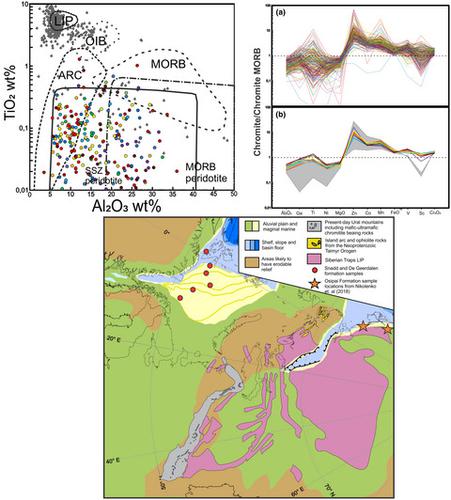当前位置:
X-MOL 学术
›
Basin Res.
›
论文详情
Our official English website, www.x-mol.net, welcomes your
feedback! (Note: you will need to create a separate account there.)
The importance of trace element analyses in detrital Cr‐spinel provenance studies: An example from the Upper Triassic of the Barents Shelf
Basin Research ( IF 2.8 ) Pub Date : 2020-08-15 , DOI: 10.1111/bre.12502 Trond Svånå Harstad 1 , Mai Britt Mørk E. 1 , Trond Slagstad 2
Basin Research ( IF 2.8 ) Pub Date : 2020-08-15 , DOI: 10.1111/bre.12502 Trond Svånå Harstad 1 , Mai Britt Mørk E. 1 , Trond Slagstad 2
Affiliation

|
Investigations of sandstone provenance often involve U–Pb dating and chemical/mineralogical investigations of detrital minerals that are stable in sediments. As most stable detrital minerals are from felsic–intermediate rocks, investigations of the only mafic–ultramafic mineral considered stable in sediments, chromian spinel (Cr‐spinel), can reveal contributions from mafic–ultramafic sources. Cr‐spinel chemical compositions are tied to petrogenesis, making it possible to identify the nature of, and differentiate between, potential sources. Earlier detrital Cr‐spinel studies have focused on major and minor element compositions, however, the advent of laser‐ablation analytical techniques now allow routine mineral trace element analyses. Here, we integrate major, minor and trace element compositions of detrital Cr‐spinel from sandstones with a well‐characterised provenance from the Triassic (Anisian to Early Norian) Snadd and De Geerdalen formations of the Barents Shelf. The analysed Cr‐spinel compositions are depleted in the major element cations Fe3+, Al and Mg and enriched in Cr and Fe2+. Relative to MORB chromite, the minor and trace element data show high concentrations of Zn, Co and Mn, low concentrations of Ni and Ga and variable concentrations of Ti, V and Sc. The major element compositions of the detrital Cr‐spinel are similar to ophiolite‐associated Cr‐spinel, while the trace element compositions indicate a more complex petrogenesis influenced by metamorphic alteration. The compositional variations between sample locations are small, suggesting similar source rocks for the detrital Cr‐spinel throughout the study area. The most likely sources of the Cr‐spinel grains are metamorphosed ophiolite complexes in the Uralian Orogen, in accordance with earlier provenance studies. The novel addition of trace element compositions to detrital Cr‐spinel studies adds significant source‐sensitive information.
中文翻译:

微量元素分析在碎屑Cr-尖晶石来源研究中的重要性:以巴伦支陆架上三叠纪为例
砂岩物源调查通常涉及U–Pb测年以及对沉积物中稳定的碎屑矿物的化学/矿物学研究。由于最稳定的碎屑矿物来自长英质—中级岩石,因此对沉积物中唯一被认为稳定的镁铁质超音速矿物(铬尖晶石(Cr-spinel))进行的调查可以揭示镁铁质超音波来源的贡献。Cr-尖晶石的化学成分与成岩作用有关,因此有可能确定潜在来源的性质并加以区分。早期的碎屑Cr-尖晶石研究主要集中在主要和次要元素组成上,但是,激光烧蚀分析技术的出现现在允许常规的矿物微量元素分析。在这里,我们整合专业,来自砂岩的碎屑状Cr-spinel的微量元素和微量元素成分,以及来自Barents Shelf的三叠纪(阿尼西亚至Norian早期)Snadd和De Geerdalen地层的特征充分的来源。分析的Cr-尖晶石成分中的主要元素阳离子Fe贫化3+,Al和Mg并富含Cr和Fe 2+。相对于MORB亚铬酸盐,次要元素和痕量元素数据显示高浓度的Zn,Co和Mn,低浓度的Ni和Ga以及可变浓度的Ti,V和Sc。碎屑状Cr-spinel的主要元素组成与蛇绿岩相关的Cr-spinel相似,而微量元素的组成表明受变质作用影响的成岩作用更为复杂。样品位置之间的成分变化很小,表明整个研究区碎屑Cr-spinel的烃源岩相似。根据较早的来源研究,Cr-尖晶石晶粒最可能的来源是乌拉尔造山带中变质的蛇绿岩复合物。碎屑状Cr-尖晶石研究中痕量元素组成的新颖添加增加了重要的来源敏感信息。
更新日期:2020-08-15
中文翻译:

微量元素分析在碎屑Cr-尖晶石来源研究中的重要性:以巴伦支陆架上三叠纪为例
砂岩物源调查通常涉及U–Pb测年以及对沉积物中稳定的碎屑矿物的化学/矿物学研究。由于最稳定的碎屑矿物来自长英质—中级岩石,因此对沉积物中唯一被认为稳定的镁铁质超音速矿物(铬尖晶石(Cr-spinel))进行的调查可以揭示镁铁质超音波来源的贡献。Cr-尖晶石的化学成分与成岩作用有关,因此有可能确定潜在来源的性质并加以区分。早期的碎屑Cr-尖晶石研究主要集中在主要和次要元素组成上,但是,激光烧蚀分析技术的出现现在允许常规的矿物微量元素分析。在这里,我们整合专业,来自砂岩的碎屑状Cr-spinel的微量元素和微量元素成分,以及来自Barents Shelf的三叠纪(阿尼西亚至Norian早期)Snadd和De Geerdalen地层的特征充分的来源。分析的Cr-尖晶石成分中的主要元素阳离子Fe贫化3+,Al和Mg并富含Cr和Fe 2+。相对于MORB亚铬酸盐,次要元素和痕量元素数据显示高浓度的Zn,Co和Mn,低浓度的Ni和Ga以及可变浓度的Ti,V和Sc。碎屑状Cr-spinel的主要元素组成与蛇绿岩相关的Cr-spinel相似,而微量元素的组成表明受变质作用影响的成岩作用更为复杂。样品位置之间的成分变化很小,表明整个研究区碎屑Cr-spinel的烃源岩相似。根据较早的来源研究,Cr-尖晶石晶粒最可能的来源是乌拉尔造山带中变质的蛇绿岩复合物。碎屑状Cr-尖晶石研究中痕量元素组成的新颖添加增加了重要的来源敏感信息。











































 京公网安备 11010802027423号
京公网安备 11010802027423号